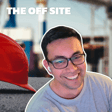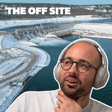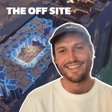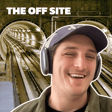Become a Creator today!Start creating today - Share your story with the world!
Start for free
00:00:00
00:00:01

What Does The Future of Geospatial Data Look Like?
In this week's episode of the Off Site Podcast, Carlos returns from paternity leave to join Jason as they talk to Steve White, General Manager of Civillo, a construction management solution in the GIS space.
The trio delve into the current state of geospatial data in construction, define the people that benefit most from geospatial products in construction as well as look to the future of what geospatial data can offer construction.
Follow Carlos on Linkedin | Follow Jason on Linkedin | Check out Aphex
Transcript
Introduction and Podcast Purpose
00:00:00
Speaker
Yeah, the intro is pre-recorded, so we'll just go straight into sort of a chat. And the general running at the beginning is we might do a bit back and forth. Jason will introduce you. I'll ask a question so you can start talking about Sevilleo. Is pronounced Sevilleo, yes? Yes, correct, yeah. It's not Spanish like Sevilleo. No, no, not Sevilleo. It's got a double L, isn't it? And that's the call. That's the intro, yeah.
00:00:27
Speaker
You're listening to the Offsite Podcast with Jason and Carlos, where we talk all things construction and technology. Join us for discussions with industry leaders and insights into the latest trends in construction. Welcome back to the Offsite Podcast. I'll cue the music.
00:00:52
Speaker
I think we'll get into play over the tops and welcome back music for Carlos.
Carlos' Personal Update
00:00:58
Speaker
This week we're joined back in the seat by Carlos, mate. New dad, how are you going? Full dad bod on show.
00:01:07
Speaker
Yeah, I'm doing all right. Full dad bod is in motion. I've only just started doing a bit of exercise to now try and reverse what's happened. But no, yeah, four weeks in, it's been great. Yeah, my wife does the heavy lifting, which allows me to still sort of function as a human. So, no. That's not what you were saying off. That was not what you were saying off recording. You're obviously being politically correct.
00:01:34
Speaker
Yeah, yeah, yeah. Yeah, I do all the night feeds and nappies. Yeah, she, she, she, she throws something out of here. She had me say that on a punk house for sure. There's no way Rosie's listening to this anyway, so it's fine. No, no, no. She's got much more interesting things to do. But no, good to be back.
00:01:52
Speaker
You can rest assured, Mike was very happy to hand the mic back to you after a few weeks away. And there's probably some UK listeners happy to have a proper British accent back on the back in their headphones. Yeah, no. Yeah, actually a massive thank you to Mike for doing that. I know it's something he wasn't like 100% keen on. So yeah, no, I've actually listened to the episodes when I was away. So you didn't drop the ball at all. It was good.
00:02:18
Speaker
Yeah. Cool. Say that as a compliment. So what was coming back like? 7 million emails to work through? It was a four figure email count. That was nice. But once you get rid of all the sales and marketing emails like the ones we send to everyone.
00:02:36
Speaker
Yeah, you can cut that pretty quickly. So, no, the team were good. They actually... I came back to no chaos and progress on most aspects of what I left, so it's weird coming back after a few weeks. You feel like you're completely out of the loop with everything, but call that pretty quickly.
00:02:53
Speaker
straight back into it mate.
Introduction to Steve White and Seville
00:02:55
Speaker
So I guess for this week what I thought we could talk about with a guest is we always see coming up in conversation in the UK and ours mapping and the importance of mapping and how different teams use mapping and we've had lots of conversations before about GIS and different products
00:03:13
Speaker
few weeks ago, Rory joined from Propeller. And so I want to introduce as a guest this week, Steve White, who's the general manager at Seville. Seville are a Australian based like survey mapping, GIS type platform used, I see increasingly by lots of the sort of large infrastructure contractors over here. So, Steve, thank you very much for taking the time to
00:03:39
Speaker
Pleasure to have you join us on this Wednesday evening. Well, thank you, guys. Yeah, it's good to be here. I've listened to a few of the podcasts over the last few weeks and months. So, yeah, it's fun to be on it. It's going to be a trip to hear myself back. Don't listen to it. That's the number one. Yeah, I'm not sure. I will actually. Pretend it never happened. Don't listen to it back. The last thing you want to do is listen to your own voice on a podcast. That is true. That's true.
00:04:06
Speaker
Cool, so I said to you just before, we might start with the most bog-standard, boring podcast interview question that ever you could get asked.
Role of Geospatial Data in Infrastructure
00:04:18
Speaker
But for those that haven't heard of Stabilo, give us the cliff notes to run through, how teams use it as, I guess, a bit of context, mate.
00:04:26
Speaker
Yeah, sure. So I guess the background behind Civilo is that we're all surveyors by trade. So working on a lot of these big infrastructure projects, like level crossings, road upgrades, things like that. A lot of geospatial data going around and a lot of owners like surveyors and GIS people and designers to have that info and have all the software to
00:04:47
Speaker
to use it. The challenge, of course, is that you have to communicate that to the rest of the projects. And that's where we have plans and cross-sections and all these different things. So the idea behind a civilla was can we take all the spatial data that we have as surveyors, put it online on a sort of easy to use web application, and allow everyone to actually access that data in a really user-friendly way. And then they can use the data themselves to do a lot of the planning, a lot of the decision making with that data without having to rely on other people.
00:05:14
Speaker
Yeah, I think I'm a big believer in that mission and the interactions that we've had and through our team with some shared customers is that's the sort of feedback they have as well, mate. I guess the idea of
00:05:29
Speaker
of geospatially or through a map being the best way to communicate or analyze or interrogate or see a lot of the data on construction projects is something that it's an idea that's been presented by I guess lots of people, I'm a big believer in it. What do you see as like the status quo or where is that, how far along that idea of everything kind of going into mapping context do you think things are at the moment?
00:05:55
Speaker
Yeah, good question. It's certainly getting better and there's more data out there and more attributes and different sorts of data going in as well. It really ranges from project to project, from company to company, of course. So the standard stuff is, you know, getting your feature survey, your aerial imagery, your design data, and overlaying that underground services and utilities as well.
00:06:20
Speaker
big one. We are seeing more and more now, more advanced 3D models, more attribution on data sets, and I guess just more sort of digital and spatial literacy I think amongst the industry now that everyone's sort of coming to grips with the fact that this stuff is really important and it really helps to give some certainty to the project knowing exactly where things are, where things are going to be and how they interact.
00:06:45
Speaker
Do you think the biggest beneficiary of the data being in that way, like on your typical project, is it like the engineer, is it the supervisor, is it the project manager, who gets the most value out of like pulling that stuff into the same place? I think you've sort of named three of the top sort of people who get value. Like I've done this before almost, mate.
00:07:08
Speaker
Definitely the engineers are really useful a lot, so it's really helpful for the planning, knowing where things are. It allows them to do markups and things like that, and do staging plans and work towards what they're going to do. Also, excavation permits, which we might talk about at some stage as well. They can use spatial data to
00:07:31
Speaker
plan for those, effectively. But supervisors as well, like in the field, I mean, from a civilian perspective, the applications mobile. So we have a lot of supervisors actually who are not really tech savvy people, let's say, have a high uptake of using it with an iPad and actually just being able to visualize the data in the field digitally rather than, you know, on a PDF plan that is sort of small and out of date. So I suppose it's those types of people that get a lot of value out of it.
00:07:58
Speaker
Back, it's been a few years for sure, back when I was on projects, like geospatial systems were kind of within the geospatial team. It wasn't as broadly used as it is now across the delivery team in particular. What's the sort of catalyst for that change? Is it the fact that like BIM models are just hard to use and time-contuming and they're never up to date? Is it drone surveys obviously sort of giving us quick fire information in a practical way? How has it sort of worked its way across teams now?
Future Integration of Geospatial Data
00:08:25
Speaker
Because it seems to be pretty common, particularly in infrastructure jobs.
00:08:27
Speaker
Yeah, I think it's got more prevalent as it's got more accessible. So I suppose, again, one of the reasons we sort of built Zavillo 10 years ago was because the sort of software that you could actually use the spatial data on was quite complex or you needed to be an expert or you needed to have access to it or have a license to it, which
00:08:50
Speaker
a lot of your construction delivery team don't have that access. So your geospatial professionals, your geospatial team, as you said, they have all that, they have all their software, they know exactly how to use it, but the rest of the team didn't. So as platforms, I suppose, develop and evolve to make that data more accessible. I think that's why we're seeing more use of geospatial data and more knowledge and uptake to use it on projects.
00:09:20
Speaker
Yeah, the accessibility element of having up-to-date, accurate information there in an app that you can actually use.
00:09:29
Speaker
I think it's really interesting to explore, Steve, the way you see the technology and the people and projects use of geospatial technology going in the future. We had talked about previously, like some applications you guys have built on top of it, but where do you see it? What do you see the workflows being that benefit from being on top of the geospatial data? And for those that don't know, I guess recently released like a permit style module
00:09:58
Speaker
And is there anything else that you see on top of it? Yeah, well, I'll start off with the dependent module since you mentioned it. But yeah, I guess one of the common workflows or common uses for spatial data that we saw our clients using, and I mentioned before, is excavation permits and underground utilities. They were creating a lot of plans and using that data, but the process was still very sort of paper-based, very manual, very time-consuming.
00:10:25
Speaker
So I think building a digital workflow to sort of go through that process is right now sort of helping to save a lot of time. And I guess the key is that you're leveraging that geospatial data from the start, and then you're sort of building that digital workflow on top of that. And I think in a similar way, where it's going to go with geospatial data is
00:10:47
Speaker
building more of those type of digital workflows, leveraging the geospatial data. So integrating with different products, products and different softwares that do different things. So for instance, like we know we've talked about with you guys at APEX, how you have integrations with geospatial platforms into your platform to link up what you guys are doing and the geospatial data. So I think
00:11:13
Speaker
That is the future of geospatial data and geospatial and digital workflows, I think, is to link up those different things.
00:11:22
Speaker
So, because there's like an interesting product question that comes up in my head that I've thought about a couple of times before. You've got this kind of one direction of travel, which is you've got like kind of a geospatial system like a Seville or an ArcGIS. There's kind of this canvas in which you can build the workflows on top of in your case like permits. And we see teams running on top of ArcGIS likes community notification processes and permit processes as well.
00:11:51
Speaker
or you've got this other products like how the world unfolds direction, which is that there are apps built for the workflow. There's the app for permitting that has a quick way to do the mapping thing, and then it generates that and sends it over to this central repository like a similar or an ArcGIS. I'm guessing you probably have a foot in both camps, but do you have a view on which way is more likely to the majority of people are likely to go?
00:12:19
Speaker
Yeah, you're right. It's a sort of, it's a fine line to balance, right? So, I mean, from our perspective, we, you know, we're never going to be able to build everything on top of Seville. And, you know, that's probably the same with a lot of other platforms. You sort of can't do everything. There's sort of, you know, struck a balance between, okay, what really makes sense to happen all within the platform, which we thought the permits did, because the spatial side of it was so heavy. But then there's also, there's also going to be other things and, you know, whether it's
00:12:49
Speaker
community outreach or whether it's planning and scheduling and things like that. If another software is really, really suited to this task and is better, I guess, than what you can build yourself, then it makes more sense to connect those platforms rather than trying
00:13:09
Speaker
do, you know, rather than try and spend the time, the money, sort of trying to do something that's already been done. That makes sense. So yeah, it's, when we sort of deal with it all the time, it's, we get a lot of requests from clients about, you know, Oh, Hey, can you sort of do this or can we do that in Seville or this in Seville? Um, and it's, it's a sort of battle every day to figure out, all right, what, you know, what can we build or what can we,
00:13:33
Speaker
Yeah, what can we integrate with? Yeah, it's challenging. I think it's the room for both.
00:13:40
Speaker
Yeah, 100%. It's like, it's actually similar to the conversation that we had the other week with Rory, where it's like, if you, I don't know if we did this on the recording or after, but the idea that you, if you build one feature or you start building something that is like, you know, a client asks, can you handle this workflow or whatever, you start building in that direction. It kind of gives everyone a glimpse of, oh, well, if we kept going in that direction, it could do this and this and this. And you kind of set yourself on a trajectory that you get pulled into that you might not have been intending.
00:14:10
Speaker
and so it's really tricky. You start going permits and they ask, can you do, I don't know, notifications. Things like that. Yeah, exactly. Then suddenly someone's like, but this QA app doesn't do this thing and you're suddenly competing with all the QA apps. I'm sure snagging comes up a lot for you to log defects and snagging. Surely that's a
00:14:38
Speaker
It is, yeah. So like, yeah, I'd mentioned QA because that sort of QA and defects theme is like you said, kind of the next logical leap when you start talking about permits and compliance. So yeah, certainly I've had a few clients say to me, like, yeah, and it looks great. When's QA coming? When's defects coming? When are we going to do it all?
00:14:57
Speaker
And yeah, we kind of like theories. There are like sort of workflows and things you can do in Savillo to manage defects, like for photos in notes and things like that as well. We also have sort of a workflow like survey requests too. And that's another one that comes up a lot, especially because a lot of surveyors and survey managers are, you know, inputting data to Savillo, managing it for the engineers and they, you know,
00:15:23
Speaker
no one seems to have the killer survey requests app. So that's another workflow as well. It's like, all right, can we build this? Does it make sense? Is there something else out there? Do we want to go down that path? Yeah, stupid defects for sure. Like you said, it certainly comes up a lot.
00:15:40
Speaker
What else is it? It'd be super interesting to think about what else is highly requested in terms of workflows, community notifications, has that come up? Yes, it has. It has a bit. I've thought about all of these things really.
00:15:57
Speaker
you know, at different levels. But I think for quite a while, we've had the idea that it'd be really great for the community sort of managers to be able to sort of map the different stakeholders, the different properties, like, you know, and put a big red mark over, you know, sort of the more difficult or sensitive stakeholders. You can sort of log. Be quiet in their Wendy's house or whatever. Yeah, yeah, exactly.
00:16:24
Speaker
or like click online and sort of say, oh yeah, we've been to this place three times and this is the last thing. It's almost like trying to squeeze a CRM into the pillow. And then that brings you back to the sort of question of, all right, should they be doing this in a CRM?
00:16:44
Speaker
take the data into Seville or can we sort of put these features into Seville itself and do the whole thing there? It must be super difficult to sort of, I guess to frame it, like everything we do or Jason's team does in product with AFex is making the tool optimised for engineers to build
Feature Prioritization Challenges
00:17:03
Speaker
Lookhead plans. It's like this
00:17:04
Speaker
very specific cohort of individuals. Because you're covering a lot of bases, centered around geospatial, is it a real challenge to actually choose who are we going to prioritize, which group of individuals? Because it's not just one team now, it's multiple teams all wanting the best solution for their department or their section.
00:17:22
Speaker
Yeah, it's very challenging and it's gotten more challenging the longer we've been doing this, the more people we've had using Savilo. It's hard for me because I'm sort of client facing, so I sort of get all these requests and I'm talking to all our clients and every day and they're asking me for all these things and I'll say, oh yeah, yeah, that's proud of your idea, but then I can just sort of take that to the front development team and they've got already a million things on their site and they're just like, oh yeah, great, we can do that, but I don't know when.
00:17:52
Speaker
It's hard to prioritize things. I guess one of the things we have always done is try and consider what is going to give the most value to the widest range of people, the most users. If we keep getting asked the same thing over and over again.
00:18:07
Speaker
pretty clear sign and this will benefit a lot of people. That's how we've built all the features to date is by the users. This is how we're using it, this is how we want to use it. But it gets a lot harder, as you said, when there's a wider range of people and more people all wanting different things. Yeah, definitely at the moment that prioritization has been quite tricky. It's one of the things we've talked about a lot lately.
00:18:34
Speaker
A hot tip. We just like five days ago published a public roadmap where people can go and look at it. They can see what we're working on. We made public or we did make public. I don't know if it's there at time of this being published. The ship dates of different things that we're working on. People can upvote and add requests to that public roadmap.
00:18:57
Speaker
which is great because it gives people visibility and it's a way for people to give you feedback on this very important thing. If you have a customer success team like we do, they go to game the system and go tell all their users to vote up.
00:19:11
Speaker
So within like a couple of hours of it being live, one of the CS team had gone and basically rallied a whole bunch of users to vote up the things they wanted to work on. So no matter what you do, it can be gained. The system can be gained. Yeah. Yeah. I was going to say, you're bold to put that out there and voting in dates and things like that. I don't think I could ever convince our guys to do that.
00:19:35
Speaker
The benefit of it is that you don't have to be the brunt of it. It can go through to, and everyone's got visibility, and just today I was getting a, when's this going to happen from a key customer in Oz, and said, it's on the roadmap. You can say, you're the only person voting for it. That's not bad, actually.
00:19:59
Speaker
So maybe you got to get some friends to go and vote for it. I was looking at your website the other day, actually, I was seeing a big tree of product development. Is that what you're referring to? No, that's gone. That used to be the old way would do that, but that got you updated pretty infrequently. It was huge. I was looking at that.
00:20:21
Speaker
and most of it's done in there. We basically swap that out for now like a more active thing that's integrated to our product, the actual setup tools that we use for the development. We expose the features that we're building, most of them, and users can give feedback that gets triaged, and then they can outvote and add comments to the existing ones. It saves all of the feedback going into this giant mess,
00:20:51
Speaker
uh, a repository that someone has to go and comb through for the four nuggets of very useful information. Yeah. That's, that's certainly something, um, well, thanks to the guys and sort of say, Hey, he's not Jason and Carlos are doing much.
00:21:07
Speaker
I guess one of the things that's interesting to think about, I think I might have done a post about this the other day on LinkedIn, it seems as though there is kind of like this organic adoption of geospatial or GIS type tools in infrastructure jobs.
00:21:22
Speaker
It feels like the BIM side has to get like pushed. It's like less organically adopted. Do your customer base also flow over to that building side and BIM or is it predominantly infrastructure and GIS? Where do you see that sort of balance between the two or is it the same thing?
BIM and Geospatial Data Integration
00:21:41
Speaker
Our user base is predominantly infrastructure. There is a bit of overlap still. We have BIM models coming to our platform on certain projects, especially rail projects with station builds and things like that. I see a lot of 3D BIM type models. I guess our experience is
00:22:00
Speaker
infrastructure sector and that's how our platforms built up so it's kind of suited more towards those long linear jobs rather than the pilot vehicle jobs. Certainly there's still room for being stuck in infrastructure as
00:22:17
Speaker
as evidenced by some of the projects that we work on. And I guess it's just more information, but it's also about integrating those models and integrating that information. So I think maybe one of the reasons it might not have taken off so much in infrastructure
00:22:34
Speaker
is I think the platforms for viewing are a bit harder to access or I think they sort of all sit by themselves, the models. So rather than sort of geo-referencing real-world items, I think a lot of models are sort of standalone arbitrary coordinate system, which sort of makes sense to the architects or the designers.
00:22:57
Speaker
doing that, but when you try and overlay it against a real-world plan or a real-world aerial image with other data on top of it, I think that's where there has been issues. But I think that's getting better as well because most of the in-type files that get brought into Civilo have coordinates these days and consider along nicely with everything else.
00:23:19
Speaker
Does that, I'd imagine, I'm trying to steer away too many product questions, but like, does that put quiet burden from a product performance perspective? Because the burden of that type of asset is significant compared to like raster images or what else you might bring in.
00:23:37
Speaker
depending on the size. But at a certain point, if you get really, really big, really, really detailed stuff, any platforms can slow down. So it can happen. I'll say that the speed of layers and speed of data is one of the things that's highly valued by our team. So they've done the best, a really good job of being able to handle those type of data sets. And we have some big ones come in. It can be viewed in 3D and used for cross-sections and things like that. But I guess the other
00:24:07
Speaker
think from our perspective is sometimes you don't need that level of detail when during construction. So it's all great to have every single little nut and bolt and every, you know, hundreds of hundreds of attributes on everything. But when you're just out there trying to, you know, trying to deliver it, trying to put it in the right area, plan for
00:24:26
Speaker
excavating, boring concrete and all those type of things. Sometimes you don't need all that information. So it's a, again, it's a sort of fine balance between how much data and detail do you need and usability and not making it too complicated for people. But yes, again, it differs on the projects as well and differs on, you know, creating those models.
00:24:44
Speaker
Yeah, 100%. I've got this same fear. We get similar requests for 3D for planning out sequences of work. You don't need the detail probably more often than not in the construction phase, but if you've got the tool, I've always been worried that people would just try and push it to a limit until it falls over.
00:25:09
Speaker
um yeah so people definitely do that uh yeah for sure Carlos sorry mate i've like hugged all the questions yeah anything you want to throw in on top oh you really put me on the spot there i just listen i just think it tells us having a dad that uh
00:25:27
Speaker
I guess, yeah, keen to understand what are the next few years look like. So we've got this clearly sort of growing geospatial sort of set of tools, focus from customers and sort of application and use within projects. Like if I go to digital construction week in London, like a third of it is now GIS. Like it's a huge proportion. Yeah. What's coming up in the next couple of years? Where do you think it will go? You've obviously got in mind some short-term plans to release certain modules with things like permits, but
00:25:56
Speaker
Nice, got short term plans in there Carlos, well done. Yeah, what's in a couple of years? What did you get excited about? Good question.
00:26:08
Speaker
I think one of the things that is the future for us is integrations, as I mentioned before, just having geospatial software integrate with everything else in construction, not sitting there in a silo and being that sort of thing. I think now with geospatial and GIS and all these different platforms more prevalent, I think that will happen because
00:26:31
Speaker
There's a growing push, I guess, for digital engineering and having everything, you know, all in the ones, all in the same systems, all talking to each other. I think that's certainly the future. I think as well about the technology, getting better like survey technology, getting better as well.
00:26:48
Speaker
that's that's changed the way I think data is captured the way data is presented as well so I'm sure you've heard about porn clouds and sort of laser scanning handheld laser scanning all those type of things that's getting a lot better as well and I suppose the key there is not to sort of get blown away by
00:27:07
Speaker
how good the technology is, how quickly you can sort of create a coin cloud, but it's like, okay, we can create a coin cloud quickly, you know, and now we can get a reference that we can extract the data we need from it. We can actually use that data in a meaningful way rather than sort of going out there, doing a big scan. Oh, here it is, make something of it. Like sort of being able to, I think that sort of scan to BIM almost, extracting automation of extraction. So AI and those sorts of tools sort of help with those.
00:27:36
Speaker
with those kind of things. I think that's definitely one for watch and definitely interested to see where the automation AI side of things does affect geospatial but also it's constructionable.
00:27:50
Speaker
Yeah, one thing for sure about construction is they don't seem to get, or we don't seem to get, I'll keep myself in the bucket for the moment, we don't seem to get too distracted by the shiny object really easily. It's like, show me the actual thing that's valuable, not that you can do this jazzy thing. So I can't stop there without then asking the question about your comment about
AI Applications in Geospatial Data
00:28:14
Speaker
AI. I get accused about going down this aisle rabbit hole too many times on podcast episodes.
00:28:19
Speaker
I'm kind of a skeptic on actual use cases at the moment. Having said that, we've got one that we're working on. I'm a bit of a skeptic on actual valuable use cases that have return on investment. What do you see in the geospatial space that could be useful without maybe giving away your roadmap?
00:28:39
Speaker
Yeah, I don't know if we're really going to be in the AI space ourselves anytime soon. But no, just a conversation I was having with one of the directors the other day, sort of mentioning that feature extraction from laser scanning point clouds might be a place where it could be really useful.
00:28:58
Speaker
rather than have a survey or a designer or a digital engineer sort of slave away trying to extract, you know, curb and trees and all these different things from these big sort of raw point clouds or, you know, raw survey data. There's AI tools. I'm sure there's probably already stuff out there that's doing this or trying to do it. Just sort of do a lot of that work for you. I think that's certainly one where I think it has potential. Yeah, other than that, like,
00:29:27
Speaker
Like you, I don't. Personally, I don't see too many for myself that I'm going to use, like at least none that have been invented yet. But that's the thing, like all sort of big technological changes, like you can never hit your room 10 years, 20 years before and then, you know, all of a sudden it's there. And we all think how do we ever live without this before? So I'm just sort of intrigued to see what pops up really.
00:29:51
Speaker
Yeah, I don't know if you have the same thing, but basically like all the tools that we use internally as like a software company have over the last year introduced AI features within the toolset. And then like you use it twice and you're like, well, that's a terribly written bit of rubbish. I might not use that again. So I haven't found anything that I like, stick with.
00:30:16
Speaker
Yeah, I tend to ignore the little right with AI, little buttons that sort of seem to pop up on everything if you know. Exactly 100%. When I talk to projects and teams, there's this like common pattern and the reason why I'm so interested and keep talking to people about the geospatial stuff is
00:30:34
Speaker
Lots of people and lots of companies, especially the bigger companies and bigger projects, have these platforms and like the big one that we won't name check. And they're dropping like tons of money on it, boatloads of money on it, and they've got whole teams managing it. The project engineer or the project manager or the site engineer, like
00:30:54
Speaker
to get anything out of it has to go make a request that takes three months for someone to do and that's not exactly right and all that caper. And so yeah, I definitely see what my perspective is in the future that there is going to be a construction specific. I don't think the big conglomerate that is across every industry is going to be the thing that wins.
00:31:16
Speaker
I don't know if you have a similar view in terms of how the sort of marketplace evolves. Yeah, I agree with everything you just said. And yeah, again, not to make it to all that civility, but that's one of the problems that we're trying to solve is to avoid the need to have spent so much money and so many resources on something that ultimately is a little bit slow and not as usable as other platforms. So
00:31:45
Speaker
I think that's one area we're trying to position ourselves is to be a really easy to use, fast way of accessing spatial data that everyone likes to use and gets a lot of value out of. So yeah, it'll be interesting to see where that goes.
Conclusion and Farewell to Steve White
00:32:05
Speaker
And I think you're right as well with your point about construction specific, because I mean, we're very construction specific in what we've built. And I think that's another one of
00:32:14
Speaker
the advantages. My mother says we're unique. Yeah. Awesome, mate. Thank you very much for taking the time. It's been a pleasure chatting with you. Carlos, welcome back. How did you feel after getting that one back under your belt? Apart from that directly pointed question when I was in my little listening world, that was all good. Steve, thank you very much for coming on. That was really interesting, mate. No worries. Thanks a lot, guys. I really enjoyed it.



















